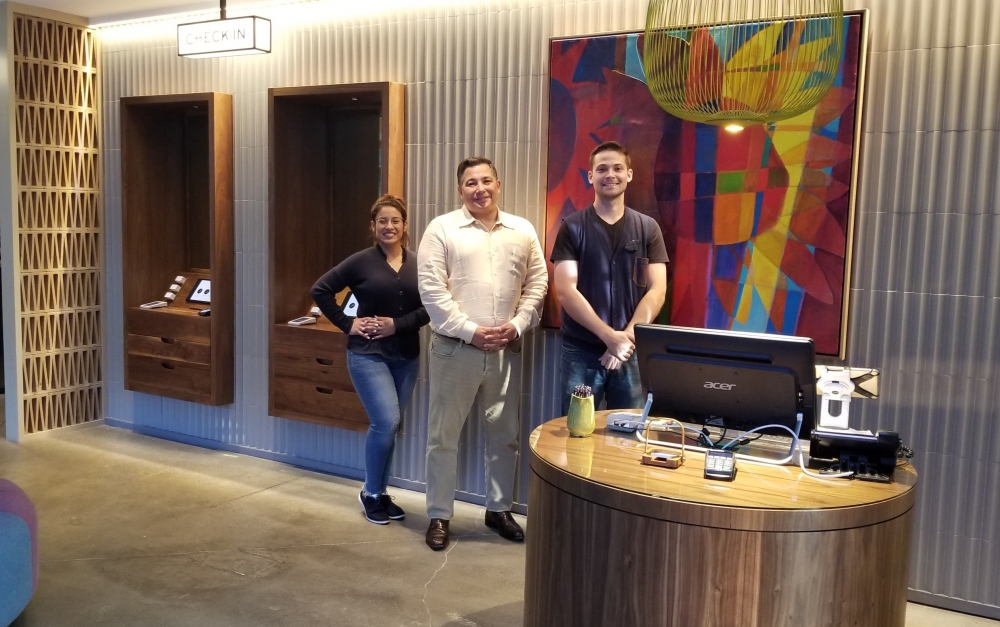
By Doug Kennedy
For decades now, some hoteliers and many hotel tech providers have been pushing hotel guests to embrace self check-in procedures. I first heard of this concept as a budding young entrepreneur floating my business plan for a hotel industry training company to the top minds in lodging. The year was 1989 and my proposed company name was Check-Inn Training. I remember one industry icon in particular who, upon seeing the name on my binder, said “Bad idea young man.” He proceeded to hand me a copy of an article from what was then called Hotel & Motel Management, in which a headline read “Front Desk Staffs To Be Replaced By Kiosk Check-in Machine.”
As the 1990s progressed, sure enough, airlines did manage to get most of the traveling public to adopt self-check-in, first at kiosks, then online and more recently by smartphone app.
Hotel guests, however, resisted. In the 1990s several large convention hotels put in automated check-in machines developed by companies such as NCR and IBM, only to see usage rejected. In 2009, Embassy Suites put two kiosk check-ins in the lobby of every company managed hotel. I was the keynote speaker at their regional brand conferences that fall and recall GM’s saying that while usage was minimal, at least you can print boarding passes with them. Some progress was made here in the 2010s, but until the last few years utilization was still very limited.
Now as we enter a new decade, it seems that recent attempts are finally taking root and guests of all generations are increasingly ready to embrace this enabling technology. As a result, it’s time for the hotel industry to reinvent the welcome.
Unfortunately, too many hoteliers are viewing self-registration only as a way to cut costs. For example, I have observed some mega-hotels in Las Vegas that are drastically cutting staff, thus increasing queue times and essentially forcing guests to opt-in. On the other hand, smart, visionary hoteliers recognize this as the perfect era to enhance the guest arrival experience.
One such is hotelier is Peter Picataggio, Manager of The Farmer’s Daughter Hotel, located in the Fairfax District of Los Angeles. I first met Peter a year or so ago when he sent me reader commentary on training articles I wrote about blending “tech and touch.” A few months ago Peter called me to say he was redesigning his entire lobby and front desk based on a vision he had. “I’m definitely not looking to reduce any staff,” he said, “I want them to have a new role, more like AirBnB Superhosts.”
When I arrived at his trendy boutique hotel, I have to say I was very impressed by his design. The iPad-like devices from his PMS provider were displayed inside attractive hardwood alcoves that afforded a sense of privacy, while a small front desk pod remained for anyone preferring traditional assistance.
During my training workshops, several of his staff shared that at first it had been an adjustment. With their traditional, large front desk now gone, they felt a bit out of place standing in an open lobby. Although I was there as a trainer, it was a learning experience for us all as we experimented, role-played and worked through the specifics of reinventing the welcome. Here are some training tips:
– A proper welcome is much easier to do without a barrier, although it feels awkward at first to be physically much closer to guests. Train your staff not to be surprised if guests initiate a handshake. (However, front desk staff should generally not initiate a handshake.)
– Encourage adoption by offering self-registration proactively. Use phrasing such as “May I assist you with using our automated self check-in system?” vs. “Do you want to use self check-in?”
– If the stations are set-up correctly with enough room in between, one front desk colleague can watch over two guests simultaneously, thus increasing efficiency.
– If a third guest enters the lobby, it is more important than ever to welcome them and essentially introduce them to the process so they will know where to wait, or else they will probably walk up to the front desk pod.
– Prepare the team with sample phrases to use when they receive push-back or negative feedback. One guest reportedly said, “You mean I have to pay $300 a night AND check myself in?” A properly front desk team can resolve this immediately by saying “Oh, of course not! I can definitely assist you with traditional registration right over here.”
– During the pre-arrival planning for the day, be sure to identify arrivals who will not be able to use self-registration, based on the limits of your PMS system and be prepared to redirect them to the traditional process. (Perhaps those with special direct billing, share-withs, etc…)
Although I had trained a long list of front desk teams at hotels that had offered various versions of automated check-in over the years, The Farmers Daughter was the first hotel I experienced that truly eliminated the physical front desk. Peter’s wonderful staff proves it can be done right, and in the end, enhance the guest experience.
This experience made me reflect on my early days a front desk clerk, which was at the end of the era of “room rack” and “key cubby hole” system. Certainly, manual systems were cumbersome, but one advantage was how quickly you could grab a room off the “rack” by simply picking up the plastic card identifying it as “ready” or “on change.” Kings were yellow, doubles green, and suites were red. Grab a room card, imprint a credit card, pick a key out of the cubby, and then you could return full attention to the guest. We held eye contact longer, smiled more, and engaged guests in authentic conversations. Even with today’s so-called “advanced” PMS systems, front desk staff still spend more time staring at their screens, while guests mostly see the top of the clerks’ heads vs. their eyes.
So I’m hopeful for the future. If our industry does this right, as Peter’s team is doing at The Farmer’s Daughter, we can reinvent the welcome. Ironically, the future welcome will feel more like the past, at least for guests who can remember that far back.


